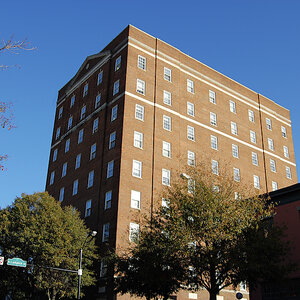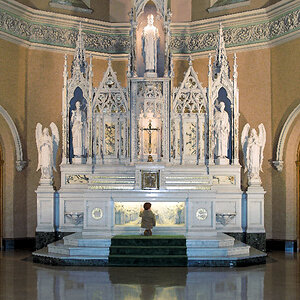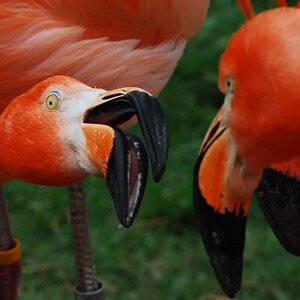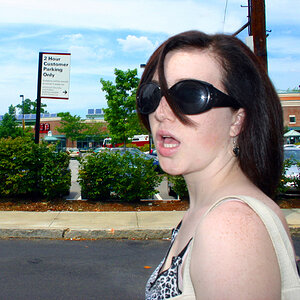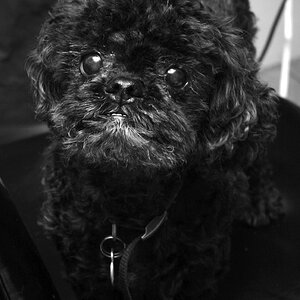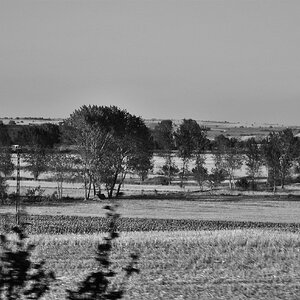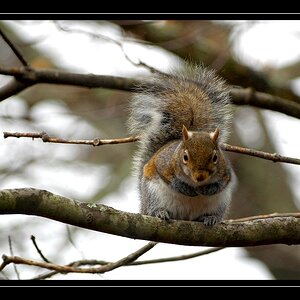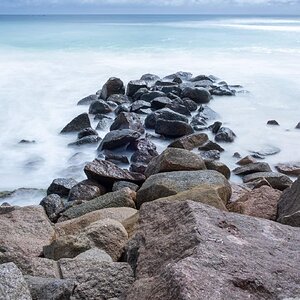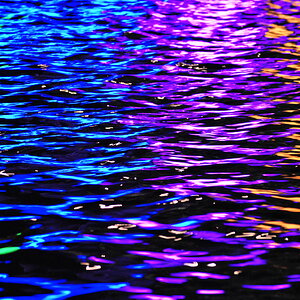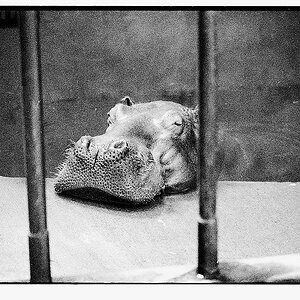Majik Imaje
TPF Noob!
- Joined
- Feb 15, 2007
- Messages
- 285
- Reaction score
- 0
- Location
- Point Hope Alaska
- Website
- majikimaje.com
- Can others edit my Photos
- Photos NOT OK to edit
and it is very simple.. here is how it works..
throw the light meter into the trash!
Now lets talk, for a bit.
I have owned and used Gossen Luna pro.. wonderful meter, GET ONE!
and you will LEARN so much, without even using it.
Lets go outside. on a sunny day..
I am uisng a luna pro meter and I have it set for 100 ISO
AS i MOVE the meter around all over the place. up down left right
on the beach, in the park, on the streets. I am watchinig the needle
move all over the place. ya know what ?? It isn't moving all that much
in other words.. I already knew all of that without even using a meter.
Outside.. bright sun, distinct shadows.. Well I know that EV in my head
because I kept looking at the luna pro.
EV 15 = 125 sec @f16
Now as I move the luna pro all over the place, I take spot readings and I take this reading and that reading .. it is right around what I already have.
it might go. a stop or even two stops when I pont it into dark areas and get up close to a tree..
but all in all.. I walk around all day long with this one ev for years.!!
and it works. perfectly.
This is what I am trying to say and I know I am not doing a good job yet of explaining it.
Photography has always been a passionate hobby of mine for decades.
4 to be exact so I am speaking with a great deal of experience.
I used to have a huge darkroom for hobby use only..
then i decided to put an add in the news paper..
Color photography classes. Print Your Own color!
I had 25 students. 4th grade to 80 years young!
I have done this for years. I know people that have no idea how to take a light reading or even how to use light meter. and they use a camera with no light meter. .and they go out and take the most gorgous photos immaginable. just by learning EV 15
this is what is going to happen.. When you learn.. (key word) learn
how to "read" the light. this takes practice.
when you learn to do this and you process your images your going to notice one thing. your Negatives are all about the exact same DENSITY
YOUR EXPOSING CONSISTENTLY.
here ..maybe this will help.. in other words. I used to teach my students.
turn off that light meter and go by what the setting INSIDE the box of film say. like this.

NOW. there are only THREE things that can happen when you press that shutter.
too dark
PERFECT
too light
I promise you. it won't take you long to learn this.! I have taught this to tooooo many people and they get fantastik awesome results.
when I go out to shoot candid personal and sometimes professionaly
I only expose one frame of film!
because I know what is going to happen from 40 years experience.
I have seen hundreds of people learn this very quickly
here is how you BEGIN to learn this. DON'T DO THIS for a critical photo shoot.
but go out and take photos and practice..and learn to read the light and JUST USE THE SETTINGS .. LISTED. stay in the sun. then the clouds
then the forests inside dark treed areas..
you have doubts.? then bracket. once you start to see the results
your gonna get more and more confidence in this technique! IT WORKS!
KEEP GOOD RECORDS! I have a friend of mine who has no idea on how to use a 35 mm camera. or even what to do with one.
BUT PUT A MAMIYA RB 67 IN HIS HANDS.. and send him outside..
his images are just breathtaking.!! because he learned these settings only.
that is ALL HE KNOWS..

I am using a mamiya rb 67 w/360 mm huge tele lens. I am 50 yards away
I can see the sun. on her right side jacket.. EV 15 BUT... I am using a big
lens that is sorta heavy. i want crisp sharp images. I know I can't use 125 @ F 16 because I just might shake a bit..
so I go to 250 and open up to F 11
instead of 125 @ F 16
Just by knowing and UNDERSTANDING the relationships. in one EV
you can re-construct all 22 EV charts in your head!
EV 15.. LETS look at the whole range
1000......5.6
500.........8
250........11
125 @ F 16 . . .125 @ F32 . . .125 @ F 11
60 ...... 22
30 ..... 32
15 ,,,,,,,45
8
4
2
1
EV 15 100 ISO = the above figures.. what if I want 400 ISO that's ev 17
the figures to the right.. what if I want 64 ISO that's EV 14
See how easy it is.. to build all these charts.. JUST BY KNOWING ONE VALUE
many people have made small fortunes in photography by getting that one shot that you would have missed if your playing with meters and other things.
LEARN HOW TO SHOOT FROM THE HIP!
then you can instantly RECOGNIZE any light situaton
practice.. your gonna be so happy you learned this!
throw the light meter into the trash!
Now lets talk, for a bit.
I have owned and used Gossen Luna pro.. wonderful meter, GET ONE!
and you will LEARN so much, without even using it.
Lets go outside. on a sunny day..
I am uisng a luna pro meter and I have it set for 100 ISO
AS i MOVE the meter around all over the place. up down left right
on the beach, in the park, on the streets. I am watchinig the needle
move all over the place. ya know what ?? It isn't moving all that much
in other words.. I already knew all of that without even using a meter.
Outside.. bright sun, distinct shadows.. Well I know that EV in my head
because I kept looking at the luna pro.
EV 15 = 125 sec @f16
Now as I move the luna pro all over the place, I take spot readings and I take this reading and that reading .. it is right around what I already have.
it might go. a stop or even two stops when I pont it into dark areas and get up close to a tree..
but all in all.. I walk around all day long with this one ev for years.!!
and it works. perfectly.
This is what I am trying to say and I know I am not doing a good job yet of explaining it.
Photography has always been a passionate hobby of mine for decades.
4 to be exact so I am speaking with a great deal of experience.
I used to have a huge darkroom for hobby use only..
then i decided to put an add in the news paper..
Color photography classes. Print Your Own color!
I had 25 students. 4th grade to 80 years young!
I have done this for years. I know people that have no idea how to take a light reading or even how to use light meter. and they use a camera with no light meter. .and they go out and take the most gorgous photos immaginable. just by learning EV 15
this is what is going to happen.. When you learn.. (key word) learn
how to "read" the light. this takes practice.
when you learn to do this and you process your images your going to notice one thing. your Negatives are all about the exact same DENSITY
YOUR EXPOSING CONSISTENTLY.
here ..maybe this will help.. in other words. I used to teach my students.
turn off that light meter and go by what the setting INSIDE the box of film say. like this.

NOW. there are only THREE things that can happen when you press that shutter.
too dark
PERFECT
too light
I promise you. it won't take you long to learn this.! I have taught this to tooooo many people and they get fantastik awesome results.
when I go out to shoot candid personal and sometimes professionaly
I only expose one frame of film!
because I know what is going to happen from 40 years experience.
I have seen hundreds of people learn this very quickly
here is how you BEGIN to learn this. DON'T DO THIS for a critical photo shoot.
but go out and take photos and practice..and learn to read the light and JUST USE THE SETTINGS .. LISTED. stay in the sun. then the clouds
then the forests inside dark treed areas..
you have doubts.? then bracket. once you start to see the results
your gonna get more and more confidence in this technique! IT WORKS!
KEEP GOOD RECORDS! I have a friend of mine who has no idea on how to use a 35 mm camera. or even what to do with one.
BUT PUT A MAMIYA RB 67 IN HIS HANDS.. and send him outside..
his images are just breathtaking.!! because he learned these settings only.
that is ALL HE KNOWS..
I am using a mamiya rb 67 w/360 mm huge tele lens. I am 50 yards away
I can see the sun. on her right side jacket.. EV 15 BUT... I am using a big
lens that is sorta heavy. i want crisp sharp images. I know I can't use 125 @ F 16 because I just might shake a bit..
so I go to 250 and open up to F 11
instead of 125 @ F 16
Just by knowing and UNDERSTANDING the relationships. in one EV
you can re-construct all 22 EV charts in your head!
EV 15.. LETS look at the whole range
1000......5.6
500.........8
250........11
125 @ F 16 . . .125 @ F32 . . .125 @ F 11
60 ...... 22
30 ..... 32
15 ,,,,,,,45
8
4
2
1
EV 15 100 ISO = the above figures.. what if I want 400 ISO that's ev 17
the figures to the right.. what if I want 64 ISO that's EV 14
See how easy it is.. to build all these charts.. JUST BY KNOWING ONE VALUE
many people have made small fortunes in photography by getting that one shot that you would have missed if your playing with meters and other things.
LEARN HOW TO SHOOT FROM THE HIP!
then you can instantly RECOGNIZE any light situaton
practice.. your gonna be so happy you learned this!


